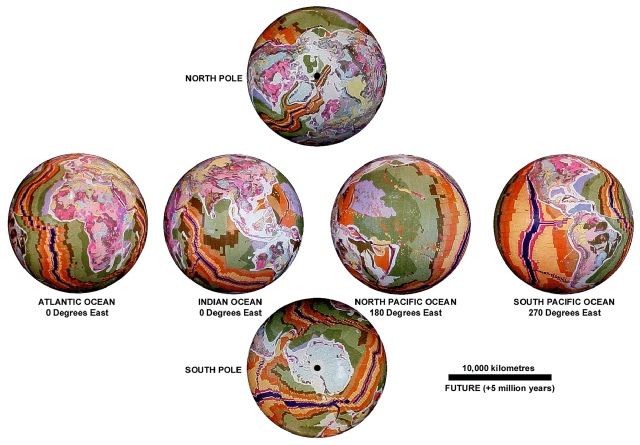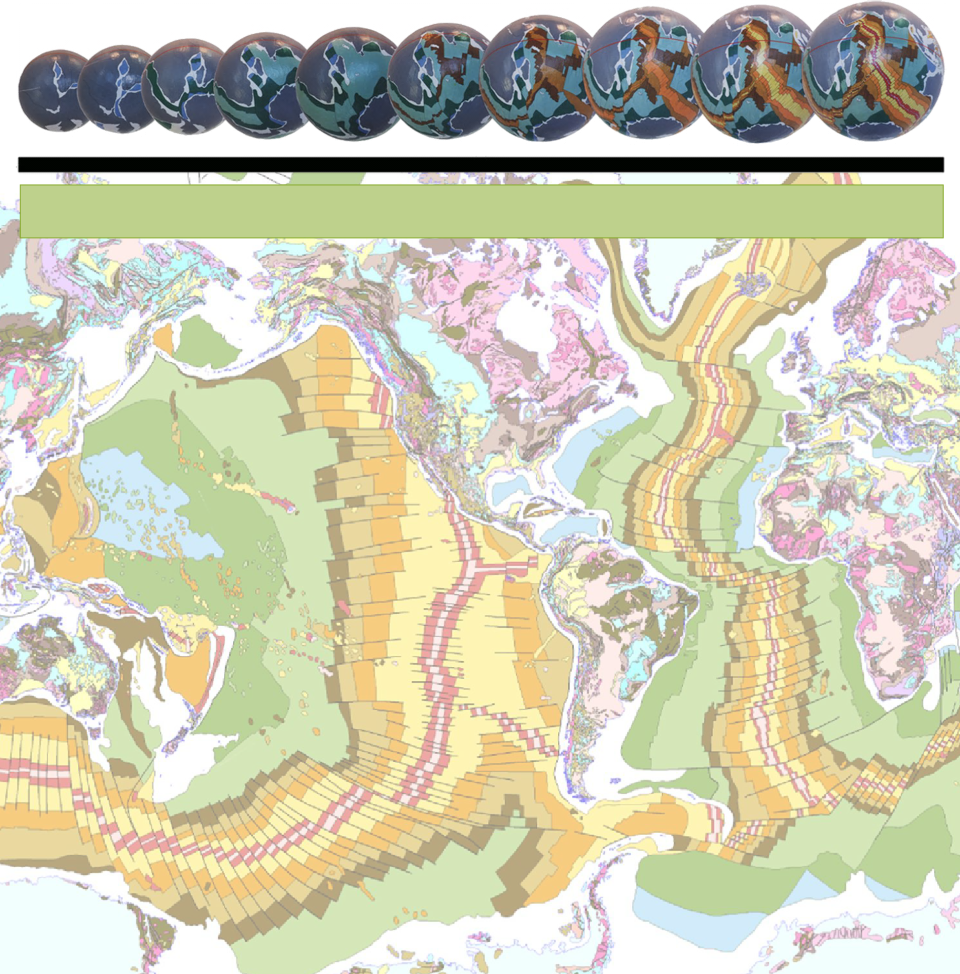FIVE MILLION YEARS INTO THE FUTURE
From the continental and seafloor descriptions of Earth’s past and present geological history the concept of an Expansion Tectonic Earth can now be projected forward in time. From this, an informed account of what may eventually happen to not only the modern continents and oceans but also the Earth itself can be confidently made. This projection into the future is readily achieved by simply calculating a future Earth radius at any moment in time and extrapolating opening of the mid-ocean-ridges throughout all of the oceans.

The Expansion Tectonic Earth projected to 5 million years into the future. The dark blue spreading ridge represents spreading along each of the mid-ocean-ridges for the next 5 million years. The model shows an extension of all mid-ocean-ridge axes into seismically active areas such as Turkey, Japan, California, and New Zealand.
A reconstruction of an Expansion Tectonic Earth at five million years into the future is shown above—which coincidently still looks very similar to the present Earth. Reconstructing the crustal plates on this future small Earth model is readily done by calculating the predicted Earth radius from the established radius formula and then adding new seafloor crust along each of the mid-ocean-ridge axes—precisely as is happening today.
Apart from the increased distances between the various continents and subtle changes to the coastlines, on this model the distribution of continents and oceans on the future Earth is shown to be essentially the same as it is today.
During this geologically short interval of time, it is calculated that Earth radius will increase by 107 kilometres to 102 percent of the present radius. The figure shows that the increase in Earth radius to 5 million years into the future is consistent with a continued increase in surface area of each of the oceans and lengthening of each of the present-day mid-ocean-ridge spreading axes. This process of lengthening of the mid-ocean-ridge spreading axes is a direct result of the increase in circumference of the Earth during an increase in Earth radius. The mid-ocean-ridge lengthening process then represents an important mechanism for future crustal development during on-going increase in Earth radius.
On an Expansion Tectonic Earth, as the mid-ocean-ridge spreading axes lengthen and the ridges open they can be visualised as being huge propagating cracks in the seafloor—which is precisely what they are. As the cracks propagate and lengthen they also continue to break-up the continental and seafloor plates into ever smaller fragments. This is currently occurring within each of the major earthquake prone areas of the world today.
In these earthquake prone areas the seismic and earthquake activity occurs as a result of the crusts cracking and breaking apart, not due to collision as portrayed in plate tectonics. This break-up is also accompanied by intrusion of volcanic lava, elevated heat flow, and expulsion of new water and gas from the mantle.
Lengthening of the East Pacific mid-ocean-ridge spreading axis on an Expansion Tectonic Earth is currently occurring as a northward extension of the spreading ridge passing through the Gulf of California. This gulf will eventually rift and separate the Californian Peninsula from North America to form an island. A northward extension of the Red Sea Rift zone through the Gulf of Aqaba and Dead Sea region into Turkey will eventually result in the rifting and separation of the Sinai Peninsula from Arabia. A northern extension of the Marianas spreading ridge is shown to be continuing towards Japan and a southern extension of the Tongan spreading ridge is also continuing through New Zealand.
Elongation of the mid-ocean-ridge spreading zones within these areas contrasts strongly with the plate tectonic requirement for plate convergence, continental collision, and subduction of vast amounts of oceanic crust.
On an Expansion Tectonic Earth, an increase in surface area accompanied by elongation of the mid-ocean-ridges is considered to better represent the break-up and separation of the continents and opening of the existing oceans when moving into the future. These mid-ocean-ridge opening processes, as projected well into the future, also continues to comply with the established seafloor geological mapping.


